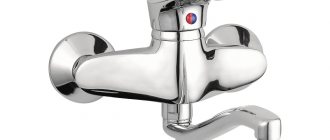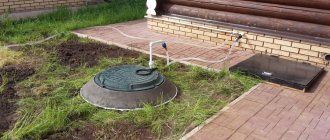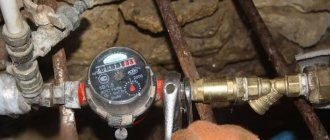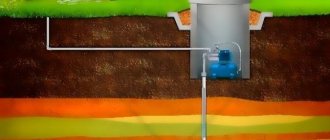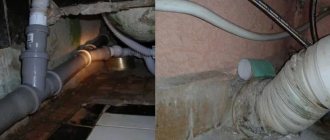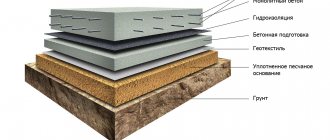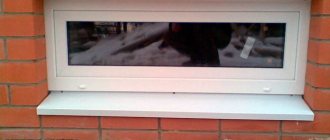Let's consider all possible ways to increase the pressure in the circuit, and the reader will determine for himself what exactly needs to be done in relation to his home. Moreover, most issues are resolved without any significant material costs.
Causes of low water pressure in the water supply
It will not be possible to increase the pressure in the pipes (what it should be according to the norm, read here) without knowing what causes the decrease in pressure in the water supply of a private house. This is where you need to start solving the problem. It is literally impossible to take into account everything, but there are a number of typical, most common “malfunctions” that you should be aware of.
- Leaks, accidents on the highway.
- Reduced pipe diameter due to foreign deposits on the internal walls of water supply sections.
- Clogged cleaning filter at the entrance to a private house.
- Defects (malfunctions) of shut-off valves.
If the water supply of a private house is centralized, then a possible reason for the decrease in pressure in the system may be poor quality work of the supplier (for example, turning off one of the pumps at the substation in order to save electricity, an accident on the highway). Before thinking about ways to increase pressure, you should ask the owners of adjacent buildings if they are experiencing any difficulties with water supply.
If this is a common problem, then first of all you need to “tease” the utility workers. Basis - provisions of SNiP No. 2.04.02 of 1984, government resolution No. 307 of 2006. The minimum pressure on the supply to a private house (for a one-story building) is 1 bar. If there is a 2nd floor - already 2.4.
In order not to run around your neighbors, it is advisable to place a control and measuring device (pressure gauge) on a “thread” between the well and the house. At least, it will be immediately clear where to look for the cause - inside or outside the home.
When is a promotion needed?
A decrease in pressure can occur at any time, and there are many reasons for this phenomenon.
If water from the tap begins to flow slower than usual, it is necessary to diagnose the pipeline .
If the home is connected to a centralized water supply, then in addition to problems in the pipes inside the room, weak pressure may appear due to interruptions in the operation of the station. Also, the supplier can save on electricity and purposefully turn off one of the pumps, as a result of which the pressure in the pipes will inevitably drop.
In this case, you should first ask your neighbors if they have a similar problem , and only after making sure that other residents connected to the same source do not have problems with water pressure, proceed to search for the cause in your home. If the pressure also drops among your neighbors, then you should contact the housing and communal services to find out.
Jemix W15GR-15 A
An excellent model that copes well with the problem of lack of pressure in the water supply circuit. A fan is used for cooling, which indicates the serious noise that this equipment generates. The device has manual and automatic control.
Characteristics:
- Maximum head – 15 m;
- Temperature limitation – from 0 to +110 degrees;
- Power – 0.12 kW;
- Productivity – 1.5 m3/hour;
- The diameter of the pipes is 15 mm.
Reasons for low pressure
Before attempting to increase the pressure, it is necessary to determine the specific cause of the situation.
The problem may occur due to:
- leaks in pipes;
- blockages in the filtration system;
- a large amount of deposits inside the pipes;
- breakdown of the locking mechanism.
A pressure gauge allows you to accurately measure the water pressure in pipes. It is installed near the entrance of the pipes into the room, as well as along the entire length of the pipeline, and near water consuming devices.
Recommendations
When connecting various additional devices to the water supply system, it is advisable to install a bypass to be able to turn off these devices without stopping the water supply.
For proper operation of household appliances, it is necessary to study their documentation. It indicates the optimal pressure at which the device should be used.
It is useful to install pressure gauges in critical parts of the water supply system to monitor pressure.
How to determine the problem in each specific case?
In private homes where water supply is provided by a pumping station, the most common cause of the problem is a clogged filter.
Therefore, the first step is to check the correct operation of the station, clean and, if necessary, replace the filtration system . It is easy to check the correct operation of the station, since a pressure gauge is installed on it by default.
In addition to the main filter installed on the water intake, you should check the operation of additional filters installed near devices connected to the pipeline.
If the water pressure is insufficient only in one specific tap, or water flows slowly, for example, into a washing machine, and all other appliances are working properly, then the problem is a clogged filter installed at the outlet, or a local leak.
If the filters are not clogged and the station is working properly, it is necessary to check the pipes for leaks . To quickly detect leaks on pipes indoors, it is advisable to install several pressure gauges in order to quickly monitor which section of pipes is experiencing a decrease in pressure.
Grundfos UPA 15-90
This pump for water supply in an apartment is installed on a pipeline and has minimal dimensions. There are no temperature restrictions. Wet rotor, i.e. Ordinary water is used as a cooling substance. The device is reliably protected from corrosion, operation in the absence of liquid and overheating.
There are three working modes:
- OFF – the pump is turned off, and the liquid passes through the pipes without pump intervention;
- MANUAL – mode of constant forced operation of the pump, in which the protection against operation without liquid does not work;
- AUTO – the equipment turns on when the sensor detects water consumption by consumers, and turns off after the consumption decreases.
Performance indicators:
- Maximum head – 8 m;
- Temperature limitation – from +2 to +60 degrees;
- Power – 0.12 kW;
- Productivity – 1.5 m3/h;
- Pipe diameter is 20 mm or ¾ inch.
Ways to increase the indicator for dwellings connected to a central water supply
There are several main ways to increase water pressure in pipes connected to the central water supply.
Using a pump
One of the simplest ways to increase the pressure in pipes is to install an additional pump into the system:
The most important thing is to choose a pump with suitable parameters.
The choice of model is influenced by the length of the pipeline, the thickness of the pipes, and the number of floors in the house. The power of the device required for a noticeable increase in pressure depends on these parameters. It is worth considering that the more powerful the pump, the more expensive it will cost.A cheap model is suitable only in rare cases, so you should not save on this device, otherwise you will not get a noticeable increase in pressure.
- The pump is installed before the pipes enter the room. To do this, a part of the pipe is cut out and fittings are attached to the ends. The pump must be screwed to the pipes on both sides, following the direction indicated in the instructions.
Hydraulic accumulator
A hydraulic accumulator is a device equipped with a container into which water is pumped and subsequently withdrawn during the day. As a rule, a hydraulic accumulator is installed immediately when assembling the pipeline, but if it was not installed initially, its connection can significantly increase the water pressure.
It happens that the hydraulic accumulator was initially chosen to be too weak. In this case, replacing the device with a more powerful one will also help solve this problem.
How to do it:
To install the device, you must select the correct location.
It should be spacious, especially when using a large tank. It is also taken into account that the tank must be accessible for inspection in case of problems, so that there must be space around it. The base must be strong and absorb vibrations.- You can connect the device to the water supply using a fitting. The fitting must have five outputs, since a pipe, pump, pressure meter and relay will need to be connected to the device.
- The meter and relay are connected using threaded connections. All connections must be sealed. The relay is also connected to the pump and the network.
- After installation, you must ensure that there are no leaks. To do this, a test run of water is done and connections are checked. They must remain dry. Otherwise, it is necessary to carefully carry out the sealing again.
By replacing some water supply systems
Improper installation of water pipes can significantly affect the water flow in a negative way. Aging of pipes and a large amount of deposits in them also leads to a drop in pressure.
If the assembly was carried out independently, without the help of specialists, it would not be amiss to check once again the correct selection of pipes and connections.
A large number of corner connections and branches, too narrow pipes in some areas will inevitably steal some part of the watercourse, reducing the pressure at the outlet.
If all other methods do not provide a significant increase in pressure, you should contact specialists to rebuild the pipeline .
Comparison table of characteristics
The table below lists the main characteristics of the pump models under consideration. By comparing them with each other, it will be much easier for you to choose a model that ideally meets your needs and wishes at work.
| Model name | View | Operating modes | Peculiarities |
| Jemix W15GR-18 A | increase in cold water supply pressure | 2 | best price-quality ratio |
| Gilex Jumbo 60-35 P-K | designed to increase the pressure of cold water supply | 2 | high motor power |
| Wilo PB-201EA | designed to work with cold water supply | 2 | high quality and reliable assembly |
| Wilo Star RS 25/4-180 | hot water recirculation device | 1 | presence of speed switch |
| Valfex VPA 15-90 | hot water circulation | 1 | cheap but reliable device |
| Valtec Vsb 04-15 | hot water supply | 1 | low energy consumption |
| Grundfos UPA 15-90 | heating systems | 2 | high motor power |
From your own well
Private houses not connected to the central water supply are provided with water from a well. In addition to the reasons discussed above, a decrease in pressure can occur due to breakdowns of the water-producing station.
Station repair
If the pressure power drops in a house where water supply is provided through a well, the first thing that needs to be checked is the correct operation of the station . Interruptions in the operation of a station can occur for various reasons and manifest themselves in various ways.
The main types of faults include:
Relay or regulator failure .
It manifests itself in the form of pressure surges, either a decrease in pressure, or a complete shutdown of the supply. It should be remembered that failure of the regulator can be caused by oxidation of the contacts and malfunctions of the control board, so in this situation you need to turn off the station and carry out prompt repairs to avoid a short circuit.- Pump failure . As a rule, pumps break down as a result of failure of other parts of the system. Replacement required.
- Battery failure . Occurs due to membrane rupture. In this case, it is replaced.
- Tank contamination . During operation, dirt may accumulate inside the tank. This is an uncommon situation; it occurs when there is excessive accumulation of silt in the well and the pump falls to the bottom, which leads to excess pressure and clogging of the accumulator.
- Check valve failure . The problem manifests itself in the form of cyclical pressure surges.
If malfunctions occur in the operation of the station, you should contact specialists to repair the system and replace faulty elements.
If the station operates correctly, the water flow in a private house can be strengthened by additional methods, such as installing a pump and tank.
Cleaning and replacing filters
A very common cause of problems is dirty filters. This applies both to the filter located at the entrance of the pipes into the house, and to the filters installed in front of the water outlets.
What to do:
- if a problem occurs, you should check the cleaning filters for contamination;
- If necessary, filters should be cleaned of deposits and replaced in a timely manner in case of malfunction.
Installing an additional pump
If cleaning the filters does not have a significant effect and higher pressure is required, then it is worth taking additional measures to increase it.
The simplest and most economical method of increasing water pressure is to install an additional booster pump. This device independently monitors pressure indicators and turns on when it drops.
The pump enhances the suction of water from the source and directs a more powerful flow to the outlet. Pumps of various price categories and capacities are available on the market.
How to choose the right model:
When choosing a pump, the required power must be taken into account.
It must meet the needs of the system. There is no need for excessive pressure: firstly, a pump with excessive power is a waste of money, and secondly, household appliances fail faster due to excess pressure.For most houses, the standard is a pressure of about two atmospheres - no less, but without significant excesses.
- The pump is installed between the hydraulic accumulator tank and water consuming devices. The location of the pump relative to the direction of flow is taken into account; it is indicated in the documentation for the pump. Connections must be sealed.
- After installation, the pump operation is checked. If the pressure has increased, it means the process was carried out correctly.
Storage capacity
If the problem is a small amount of water entering the room, the solution will be not only to clean the filters and increase the pressure in the pipes, but also to ensure a continuous flow.
A device such as a storage tank can help with this . The essence of its work is simple - water from the well accumulates in a tank, and from there it flows through pipes to the taps.
The tank is filled automatically, and when the taps are opened or consumer devices are turned on, it dispenses water using a pump.
How to choose a tank:
you should choose a tank based on the norm of water consumption; it is better to choose a container whose volume will be equal to daily consumption, or even more;- when using a tank, a bypass should also be installed in the system - this is necessary so that in the event of breakdowns in the operation of the station, the system can be deactivated without the need to shut off the water supply;
- It is necessary to regularly clean the tank, as harmful microorganisms and deposits accumulate in it over time.
Wilo PB-088EA
This unit is quite compact and is equally suitable for transporting both hot and cold media. The equipment is cooled by liquid passing through it. The device can operate in automatic and manual mode. The automatic mode is activated by a special sensor that monitors water consumption. The Wilo pump is resistant to overheating and makes virtually no noise while pumping liquid.
The performance indicators of this model are as follows:
- Maximum head – 9.5 m;
- Temperature limitation – from 0 to +60 degrees;
- Power – 0.09 kW;
- Productivity – 2.1 m3/hour;
- The diameter of the inlet pipes is 15 mm or ½ inch.
What else needs to be considered?
In addition to the inconvenience of using the water supply, low pressure in the pipes can lead to malfunctions of the devices. To prevent this, you need to study the instructions for each of the plumbing elements in the house.
The instructions for each device indicate such a parameter as the nominal pressure. Excessive pressure, as well as using the device at insufficient pressure for a long time can lead to breakdown.
Therefore, it is worth monitoring the water pressure in the pipes. To do this, a measuring device should be installed near each H2O consuming device .
Scope of application of booster pumps
A pump that increases water pressure allows you to create sufficient pressure in the water supply system. The standard pressure in the circuit should be about 4 atm, but in practice this value rarely exceeds 1-1.5 atm. Most washing machines can operate at a pressure of 2 atm, not to mention more demanding devices.
However, excessive pressure is also a problem, since all parts of the water supply network have a certain safety margin. When the pressure in the circuit exceeds 7 atm, the system pipes may fail and burst. The same statement can be applied to other components of the water supply system.
In order for the water supply in the apartment to work correctly, the pressure must be maintained at the same level. Of course, in practice it is impossible to maintain a precisely specified pressure value, but small deviations from the norm are quite acceptable. To achieve this goal, pumping equipment is used, which is connected directly to the inlet pipeline of the water supply circuit.
Preventive measures
To prevent the problem of insufficient water pressure from arising, it is necessary to apply preventive measures.
A good practice would be to install pressure gauges along the entire length of the pipeline - near the pipeline entrance to the house, near branches and near consumer appliances.
This will allow you to promptly detect a decrease in pressure and quickly find out the cause of the problem. Also, filters should be regularly checked for contamination and, if necessary, cleaned.
